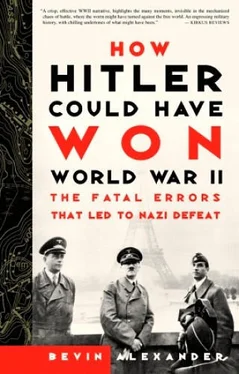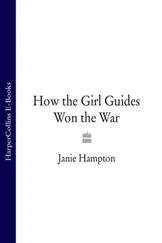Moreover, the British deployed 170 decidedly superior tanks, American Grants, carrying a side-mounted high-velocity 75-millimeter and a turret-mounted 37-millimeter gun and 57 millimeters of armor. The British had 230 more Grants in reserve. The Grant’s disabilities were a high silhouette and a limited traverse of the 75-millimeter gun. The closest German competitors were nineteen new Mark III Specials mounting a long-barreled, high-velocity 50-millimeter gun and 50 millimeters of armor. Older Mark IIIs, armed with a short-barreled 50-millimeter gun, and Mark IVs, mounting a short-barreled 75-millimeter gun, made up the bulk of Rommel’s strength. They could be shattered by the Grant’s gun at ranges beyond either tank’s capacity to penetrate the Grant’s armor.
The British also armed their motorized infantry with the new six-pounder (57-millimeter) antitank gun, possessing 30 percent more penetration than the German 50-millimeter AT gun. The German 88-millimeter AA gun remained the most formidable tank killer on either side, but Rommel had only forty-eight of them.
The Germans assembled 542 aircraft, the RAF assembled 604. But, with improved Me-109 fighters that outclassed the British Hurricanes and American-built P-40E Kittyhawks, the Luftwaffe was dominant in the early stages of the campaign.
The British position rested on a heavily mined fifty-mile-long defensive line of 13th Corps, now commanded by Lieutenant General W.H.E. “Strafer” Gott. It ran from Gazala on the Mediterranean to Bir Hacheim, where the 1st Free French Brigade of 4,000 men, plus a small Jewish Brigade, held a strongly fortified “box,” or defensive “hedgehog” perimeter.
For ten miles on the north the 1st South African Division manned a firm sector. Below it, however, the three brigades of the British 50th Division occupied widely separated defensive boxes, flanked only by minefields. Two boxes were most exposed: the division’s 150th Brigade at Got el Ualeb, half a dozen miles south of the east-west Arab caravan route Trigh Capuzzo, and, sixteen miles farther south, the Free French box at Bir Hacheim.
Some thirty miles southeast of Gazala and twelve miles east of the 150th Brigade box was Knightsbridge box, held by the 201st Guards Brigade, at the junction of the Trigh Capuzzo and a north-south Arab trail. About twenty miles east of Knightsbridge and seventeen miles south of Tobruk was the El Adem box, garrisoned by parts of 5th Indian Division.
The Gazala line evoked memories of powerful defensive positions along the western front in World War I. It was a product of the close association of British generals with infantry, not mobile, warfare. But a static defensive line was bound to lead to disaster in desert warfare. As Rommel pointed out, any position in North Africa had an open desert flank on the south and could always be turned. To be successful, defense in the desert had to be conducted offensively.
The boxes also might be bypassed or surrounded and forced to surrender. An added problem was that the new British forward railhead and supply base was only forty-five miles east of the Gazala line at Belhamed. The vast supplies there made British commanders hesitant to maneuver armor in any way that might uncover Belhamed.
Behind the Gazala line the British had a mobile reserve: the 1st and 7th Armored Divisions in 30th Corps, still under Lieutenant General C. W. M. Norrie, with three brigades of cruiser tanks (including the Grants). However, the British continued to divide their armor, leaving two brigades of “I” (infantry) tanks (mostly Matildas) posted in support of the 1st South African and 50th Divisions.
German intelligence had clear signs that the British were building up for an offensive. Since the southern flank lay wide open, a bold British armored strike around it into the rear against the Axis supply line could force Rommel’s army to abandon the field. Retreat would be fraught with difficulties, because most of the Italian divisions were nonmotorized.
“But the British were not to have the chance of exploiting their opportunities,” Rommel wrote, “for I had decided to strike first.”
Generals Auchinleck and Sir Neil Ritchie, commanding 8th Army, were not ready to commence their offensive, and posted their armor defensively in case Rommel did attack. Oddly, Auchinleck thought Rommel was not likely to strike around the undefended southern flank, but would drive into the center along the Trigh Capuzzo. He advised Ritchie to concentrate his two armored divisions along this trail, so that he could move against a thrust along it or meet a turning move around the flank if it did come.
Ritchie, instead, kept 1st Armored (with the 2nd and 22nd Armored Brigades) around the Trigh Capuzzo, and sent 7th Armored, with its single 4th Armored Brigade, southward to support the French at Bir Hacheim and the 3rd Indian Motorized Brigade holding a guarding position a few miles east. Thus, as the battle opened, British armor was split into three segments: two “I” brigades (the 1st and 32nd) in the north, 1st Armored in the center, and 7th Armored in the south.
Rommel had planned all along to swing around the southern flank. But to disguise this move, he ordered trucks and tanks driven in circles behind the Gazala line to deceive the British into thinking he was assembling armor. In daylight just before the attack, he sent all motorized forces toward the Italian infantry divisions detailed to demonstrate along the Gazala line, then brought them to their assembly points after nightfall.
Rommel’s striking force consisted of Africa Corps (15th and 21st Panzer Divisions), the 20th Italian Motorized Corps (Ariete Armored and Trieste Motorized Divisions), and 90th Light Division. The whole force was to circle around Bir Hacheim. The Italians were to storm and take Bir Hacheim in a coup de main, thus opening a shorter supply corridor, while Africa Corps was to strike directly for Acroma and the coast, cutting off and destroying the armor and troops along the Gazala line. At the same time 90th Light, with trucks mounting aircraft engines to simulate dust clouds raised by advancing tanks, was to push into the El Adem–Belhamed area, about fifteen miles southeast of Tobruk, and cut off the British from their supplies and reinforcements.
On the night of May 26, 1942, after Italian infantry under German General Ludwig Cruewell made a diversionary frontal assault against the Gazala line, Rommel’s mobile forces in 10,000 vehicles struck out in moonlight through swirling dust and sand. Luftwaffe planes dropped flares on Bir Hacheim to show the drivers the limit of the British lines. By daybreak, having encountered no opposition, the force was east of Bir Hacheim and the Germans set out at full speed for the British rear. The Italians turned back to storm Bir Hacheim, but were stopped by mines and French antitank fire.
By 10 A.M. on May 27, 90th Light seized El Adem and numerous supply dumps, but stirred up a furious battle with British forces in the area.
At the same time, Africa Corps, now under General Walter Nehring, collided with 4th Armored Brigade fifteen miles northeast of Bir Hacheim near Bir el Harmat. In violation of Rommel’s orders, Nehring’s panzers attacked without artillery support. They were stunned by the long-range penetrating power of the 75-millimeter Grant gun. Tank after tank burst into flames or was disabled. Only after they had brought up antitank guns and 88s were the Germans able to make headway. Tanks now worked around the enemy flanks, finally shattering the British brigade, whose remnants fell back toward El Adem.
As 4th Armored Brigade drew away, 21st Panzer drove northward, overwhelmed 3rd Indian Motorized Brigade in a forty-minute fight, and shattered 7th Motorized Brigade trying to hold a position a few miles on.
In the late morning the British 22nd Armored Brigade arrived from the north. An officer with an advance element wrote: “On topping a rise we could see on the eastern skyline a solid mass of vehicles stretching southward into the haze as far as the eye could see.” This was Africa Corps moving toward the Trigh Capuzzo.
Читать дальше


![Джонатан Димблби - Barbarossa - How Hitler Lost the War [calibre]](/books/385421/dzhonatan-dimblbi-barbarossa-how-hitler-lost-the-w-thumb.webp)









